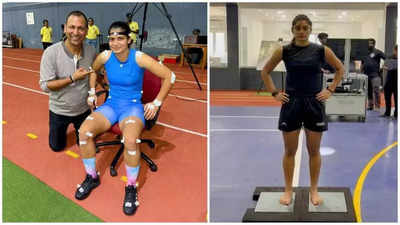Biomechanics brought in to improve drag flickers’ game

Kolkata: One of the major reasons the Indian women’s hockey team failed to make it to the Paris Olympics last year was their inability to score from penalty corners. To ensure that it’s not an issue in the coming days, Indian coach Harendra Singh is leaving no stone unturned.
For a start, he made the team’s top two drag flickers – Deepika and Manisha Chauhan – undergo biomechanic tests over three days in December at the Centre of Excellence in Biomechanics cum High-performance Centre for Sports under Tamil Nadu Physical Education and Sports University, Chennai.
He is also bringing in former Dutch penalty corner specialist Taeke Taekema to train the girls at the ongoing camp in Bhubaneswar.
Speaking about the tests, India coach Harendra Singh said, “It will help us know what percentage of a muscle is being used during the drag flicks and (which are) the muscles that are not being used and how we can make use of them. With the information we can then work on strength and conditioning of the muscles and in the long run, it will also help in injury prevention.”
Although he had done it with the two drag flickers on a smaller scale during his stint in the US, it’s the first time that he has done the same in India. Interestingly, though, he got the idea when he saw Neeraj Chopra train at the Chula Vista Elite Athlete Training Centre in California during 2021-22.
“When I saw Neeraj training, I realised the importance of biomechanics in hockey because in javelin – like in drag flicks – they have to plant their left foot before making the throw,” Harendra explained.
“Similarly, in the case of drag flicks, the speed and strength of the shots depend on how far the foot is planted. After that, the knee flexors, glutes and abductors all work in tandem to help the player make the shot.”
The entire process also helped the coach understand another key aspect of drag flick — when the ball must be released and the position of the head.
“In case of Deepika, her head used to come up before releasing the ball and it resulted in the shots going off target. Meanwhile, Manisha, too, puts her head up quickly and at times lets go of the ball too early,” the coach further added.
Speaking on the whole process, Dr. Rajnikumar, who is the head of the Centre of Excellence in Biomechanics and a former goalkeeper himself, said, “Besides checking muscle strength and power using an isokinetic dynamometer, force frame and Nordic curl, we used a 3D motion capture system integrated with a force plate to get all the kinematic and kinetic data like angular velocity, stick velocity, ball release speed and ground reaction force.”
And they did it inside the the biggest biomechanics lab in South Asia, on artificial turf under different scenarios. “First, they just took the shot, then we had the pusher and the stopper and finally we introduced the rusher,” said Rajnikumar, who is still in the process of interpreting the data.
Once done, he will send it to Harendra, who will start working with the two drag flickers based on the findings.
Meanwhile, speaking of the experience, both Deepika and Manisha sounded over the moon and believed it would help them perfect the craft ahead of the big events next year.
“The whole experience was exciting and we got to know how much power we have and where we are lacking,” said Deepika, who scored a brilliant goal in the Hockey India League past Savita from the PC.
“I’ve learned many new things about my body position. Because I’m tall, I need to take longer steps and bend more. Also, I’ve learned how to reduce double touch on the stick and when to release the ball,” explained Manisha.
While they will learn more once the coach gets all the interpretations from the Chennai lab, the important thing is that the team is moving in the right direction.
















